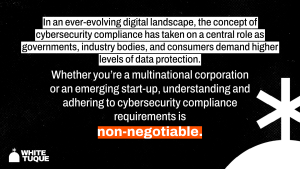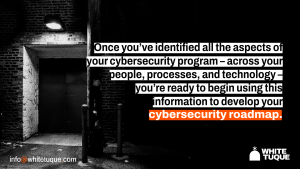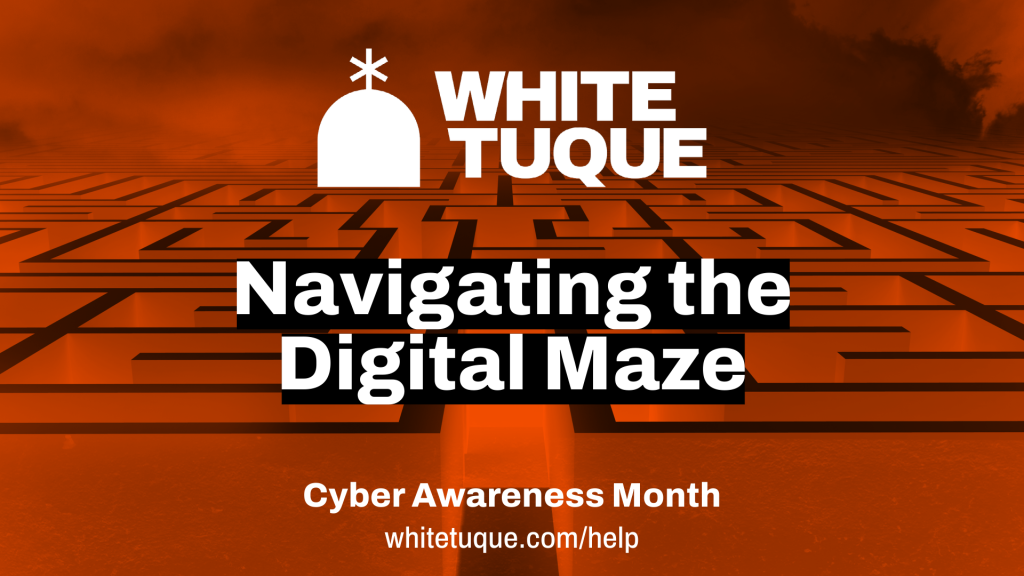By White Tuque’s Consulting & Advisory Team
October 6, 2023
In an ever-evolving digital landscape, the concept of cybersecurity compliance has taken on a central role as governments, industry bodies, and consumers demand higher levels of data protection. Whether you’re a multinational corporation or an emerging start-up, understanding and adhering to cybersecurity compliance requirements is non-negotiable.
So, how can you determine if you are meeting the standards and regulations your business is required to satisfy? If you’ve wondered, “Do I need a SOC2? Should I be thinking about meeting an ISO standard?” then you’re not alone. Our clients ask us questions like these all the time! A great place to start is to assess and understand your organization’s security posture (the policies, procedures, and technology you use today), and then you can begin to determine what you need to do next.

Use a Compass: Define Your Current Status
To understand the capabilities of your cybersecurity program, you need to have an understanding of your existing cybersecurity policies and procedures. Depending on what fits your business, you have the option of working through two approaches: process-based or asset-based.
The process-based approach involves evaluating every process that you’ve established across your organization, with respect to security. For example, what are your processes for onboarding a new employee? You will review many documents that include personal information such as their SIN, salary information, and other sensitive details. Here, there are a few security considerations to make:
- How do I secure my employee’s information?
- How do I ensure this employee follows due security process as they execute their duties?
As the name suggests, the asset-based approach to cybersecurity assessment is a strategy that focuses on identifying and protecting an organization’s most critical assets, rather than attempting to defend the entire network and every piece of data. This approach recognizes that not all assets are of equal value or importance to an organization’s operations and security posture. By prioritizing and protecting the most valuable assets, an organization can allocate its cybersecurity resources more effectively and efficiently. Let’s consider an example. For a retail company, the CRM tool could be their most critical asset, storing customer data, corporate intellectual property (IP), and financial information. In this example, their entire approach would be based around the support to secure this critical asset.

Develop a Roadmap to Plan Your Cyber Journey
Once you’ve identified all the aspects of your cybersecurity program – across your people, processes, and technology – you’re ready to begin using this information to develop your cybersecurity roadmap. When embarking on any new journey it’s best to be prepared with some idea of where you’re heading, and this kind of planning applies to developing your organization’s cyber-readiness as well.
A well-structured roadmap guides your organization in addressing current risks, adapting to evolving threats, and aligning cybersecurity initiatives with business objectives. There are several key components to developing a cybersecurity roadmap.
- Conduct a current state assessment.
- Begin by evaluating your organization’s existing cybersecurity posture. Identify strengths, weaknesses, vulnerabilities, and areas for improvement.
- Evaluate external threat landscape.
- Consider emerging threats and industry-specific risks that may affect your organization.
- Define your security goals and establish a priority matrix.
- Establish clear cybersecurity goals and objectives that align with your organization’s overall business goals. Consider how cybersecurity supports and enables the business mission.
- Identify resources and allocate those resources to your security goals.
- Determine the financial resources required to achieve your cybersecurity objectives. This includes costs for personnel, technology, training, and other cybersecurity investments.
- Identify the appropriate security controls and integration to support the projects.
- Identify and prioritize the cybersecurity controls and technologies that will mitigate your highest-priority risks. Ensure that selected controls and technologies integrate seamlessly with existing systems and processes. Check and verify you have the staff to manage the security controls.
- Provide the relevant training for employees to adopt new policies and processes.
- Implement training programs to educate employees about cybersecurity best practices and ensure policy adherence.
- Establish an incident management process.
- Create a detailed plan that outlines the steps to follow in the event of a cybersecurity incident. Test and update this plan regularly.
- Define a process to test and adapt to the lessons learned.
- Implement real-time monitoring tools and processes to detect and respond to security incidents promptly. Define KPIs and metrics to measure the effectiveness of your cybersecurity program. Regularly assess progress toward goals.
Travel with a Trusted Guide
Having a travel companion with experience is an invaluable resource. A guide who can show you the absolute not-to-be-missed activities, who can foresee potential pitfalls, and who can maximize the experience. Our team of experts are exactly this – your travel guide along your cybersecurity journey.

We understand that not every path is the same, with different obstacles, limitations, and available resources along the way. Not to mention the fact that the objective of each organization’s cybersecurity plan is unique to that business. White Tuque’s team is here to help, regardless of the size of your organization or the type of business you operate. Our Cyber Ready Plan and Cyber Risk Management programs are designed with this fact in mind. We scale our approach based on what makes sense for your business and its needs. Whether you’re just starting out on your cybersecurity path or if you’re ready to go beyond the basics with cost of breach summaries and exercises, White Tuque has a package and a plan that will fit your goals. Don’t navigate the digital maze alone. We’re here to help.


